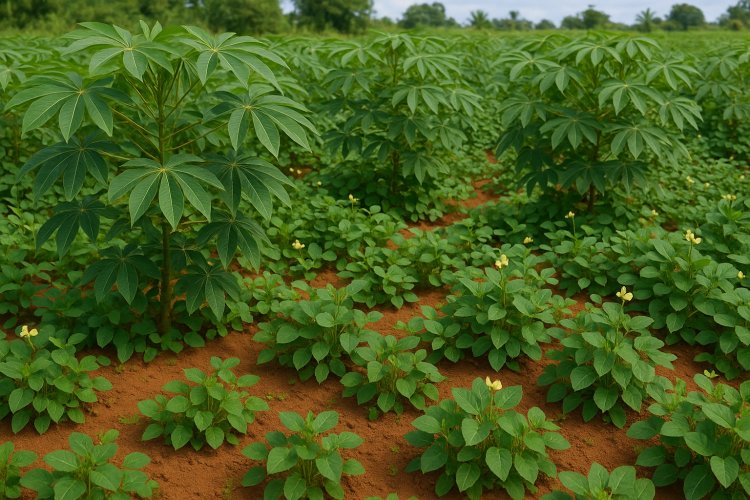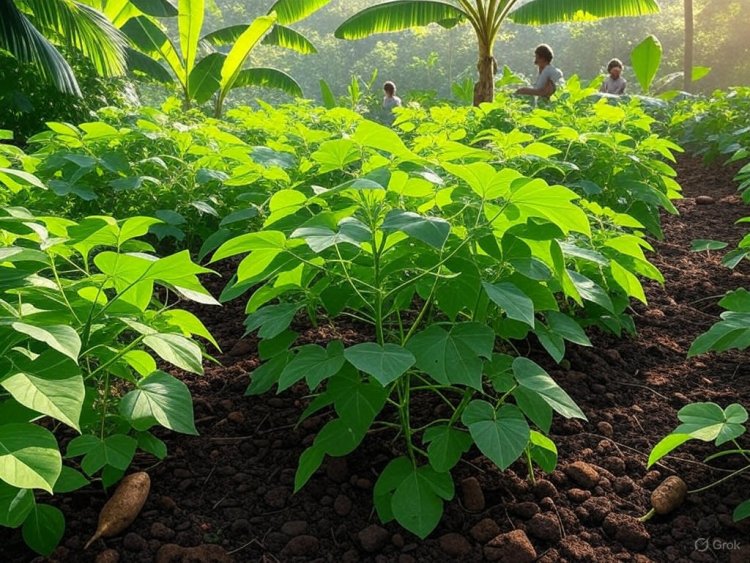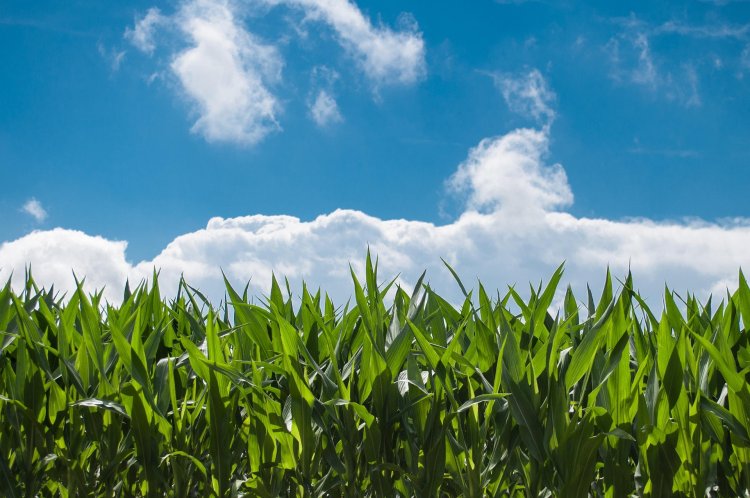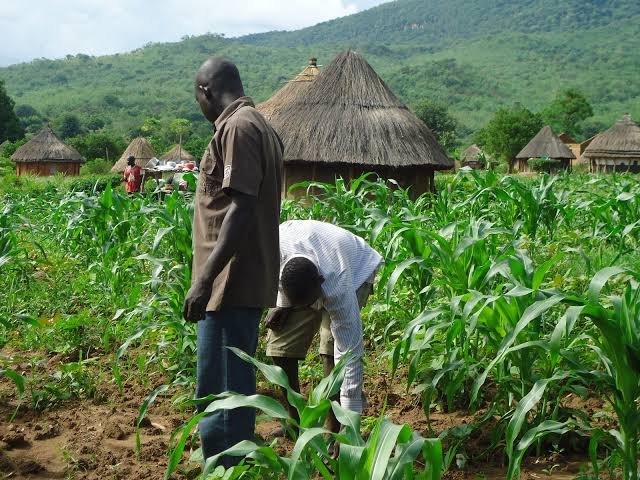Can Intercropping Transform Your Cassava Farm? Unlock Higher Yields with These Advanced Techniques!
Learn how intercropping can boost your cassava farm’s yields! Discover the best companion crops, advanced techniques, and tips for sustainable farming success.

Intercropping, the practice of growing two or more crops together in the same field, is a game-changer for cassava farmers seeking to boost productivity, enhance soil health, and manage pests sustainably. This advanced blog explores the science and art of intercropping in cassava farming, offering detailed strategies to maximize yields while minimizing risks. Whether you’re a smallholder or managing a large-scale farm, these expert techniques will help you harness the power of intercropping for a thriving cassava operation.
Why Intercropping for Cassava Farming?
Cassava, a resilient tropical crop, thrives in diverse agroecosystems, but monoculture farming often leads to soil degradation, pest buildup, and lower economic returns. Intercropping addresses these challenges by:
Enhancing Soil Fertility: Nitrogen-fixing companion crops like legumes enrich the soil, reducing the need for synthetic fertilizers.
Pest and Disease Management: Diverse crops disrupt pest life cycles and reduce the spread of diseases like cassava mosaic disease (CMD).
Maximizing Land Use: Intercropping allows farmers to grow multiple crops on limited land, increasing overall productivity.
Economic Diversification: Harvesting multiple crops provides income stability, especially for smallholder farmers.
Climate Resilience: Diverse cropping systems are better equipped to withstand drought, floods, and other climate challenges.

cowpea....
Best Companion Crops for Cassava Intercropping
Choosing the right companion crops is critical for successful intercropping. The ideal companions complement cassava’s growth habits, nutrient needs, and pest resistance. Here are top choices:
1. Legumes (Cowpeas, Groundnuts, Soybeans):
Benefits: Fix nitrogen in the soil, improving fertility for cassava. Their low canopy minimizes competition for sunlight.
Example: Intercropping cassava with cowpeas can increase soil nitrogen by up to 40 kg/ha, boosting cassava tuber yields.
2. Maize:
Benefits: Fast-growing maize provides shade, reducing weed growth. Its short growth cycle allows harvest before cassava fully matures.
Example: In Nigeria, cassava-maize intercropping has increased total farm output by 20–30% compared to monoculture.

maize farm...
3. Vegetables (Okra, Peppers, Eggplant):
Benefits: Fast-maturing vegetables generate early income while cassava develops. Their root systems avoid competition with cassava’s deeper roots.
Example: Okra intercropped with cassava in Ghana has been shown to reduce whitefly populations.
4. Pest-Repellent Crops (Onions, Garlic, Marigolds):
Benefits: Repel pests like whiteflies and cassava mealybugs with natural compounds. Marigolds release chemicals that deter nematodes.
Example: Planting marigolds around cassava fields can reduce nematode damage by up to 50%.
5. Root Crops (Sweet Potatoes):
Benefits: Low-growing sweet potatoes suppress weeds and improve soil structure without competing heavily with cassava.
Example: In Uganda, cassava-sweet potato intercropping has improved land use efficiency by 25%.
Advanced Intercropping Systems for Cassava
1. Strip Intercropping
How It Works: Plant cassava and companion crops in alternating strips (e.g., 4 rows of cassava followed by 2 rows of cowpeas).
Advantages: Reduces competition for resources, facilitates mechanized farming, and simplifies harvesting.
Best For: Large-scale farms with access to machinery.
2. Row Intercropping
How It Works: Plant cassava in rows with companion crops like groundnuts or vegetables between them.
Advantages: Maximizes space use and allows easy access for weeding and monitoring.
Best For: Smallholder farms with limited land.
3. Relay Intercropping
How It Works: Plant a fast-maturing crop (e.g., maize or beans) before or shortly after cassava, harvesting it before cassava reaches peak growth.
Advantages: Generates early income and reduces competition as cassava matures.
Best For: Farmers seeking quick returns alongside long-term cassava yields.
4. Mixed Intercropping
How It Works: Randomly mix companion crops with cassava in the same plot.
Advantages: Promotes biodiversity and reduces pest pressure but requires careful planning to avoid competition.
Best For: Organic or low-input farming systems.

Optimizing Intercropping for Success
To ensure intercropping delivers maximum benefits, follow these advanced strategies:
Timing and Spacing:
- Plant companion crops at the right time to avoid competition. For example, plant maize 2–3 weeks before cassava to stagger growth cycles.
- Use optimal spacing: cassava rows 1–1.5 meters apart with companion crops like cowpeas planted 30–50 cm apart within rows.
Nutrient Management:
- Apply organic compost or manure to support the nutrient demands of multiple crops.
- Use precision fertilization to target nutrient needs of each crop, e.g., phosphorus for cassava and nitrogen for maize.
Pest and Disease Monitoring:
- Regularly scout for pests like whiteflies or mealybugs, which may exploit diverse crops.
- Use yellow sticky traps or introduce natural predators like ladybugs to control pest populations.
Water Management:
- Ensure adequate irrigation, as intercropping increases water demand.Drip irrigation is ideal for precise water delivery.
- Mulch with organic materials to retain soil moisture and suppress weeds.
Crop Rotation Post-Harvest:
- Rotate intercrops with non-host crops in subsequent seasons to prevent pest and disease buildup.
- Example: Follow cassava-maize with a legume-only crop to restore soil nitrogen.
Challenges and Solutions in Cassava Intercropping
Competition for Resources:
Solution: Choose companion crops with complementary growth habits (e.g., shallow-rooted legumes with deep-rooted cassava).
Example: Cassava-soybean intercropping minimizes root competition.
Increased Labor:
Solution: Use mechanized planting and harvesting where possible, or train community labor groups for efficiency.
Example: Strip intercropping reduces labor needs for large farms.
Market Risks:
Solution: Select companion crops with strong local demand to ensure profitability.
Example: Intercrop with peppers or okra in areas with high vegetable demand.
Emerging Trends in Cassava Intercropping
Climate-Smart Intercropping: Combine drought-tolerant crops like cowpeas with cassava to combat climate change impacts.
Technology Integration: Use drones to monitor crop health and detect nutrient deficiencies in intercropped fields.
Agroforestry Integration: Incorporate trees like Leucaena or Gliricidia in cassava fields to provide shade, improve soil, and supply fodder or fuelwood.
Conclusion
Intercropping is a powerful tool to transform your cassava farm, offering higher yields, better soil health, and resilience against pests and climate challenges. By carefully selecting companion crops, optimizing spacing and timing, and leveraging modern technologies, you can unlock the full potential of your farm. Ready to revolutionize your cassava farming? Start experimenting with these intercropping strategies today and share your success stories!
Which intercropping system works best for your cassava farm? Share your tips below!
What's Your Reaction?





















